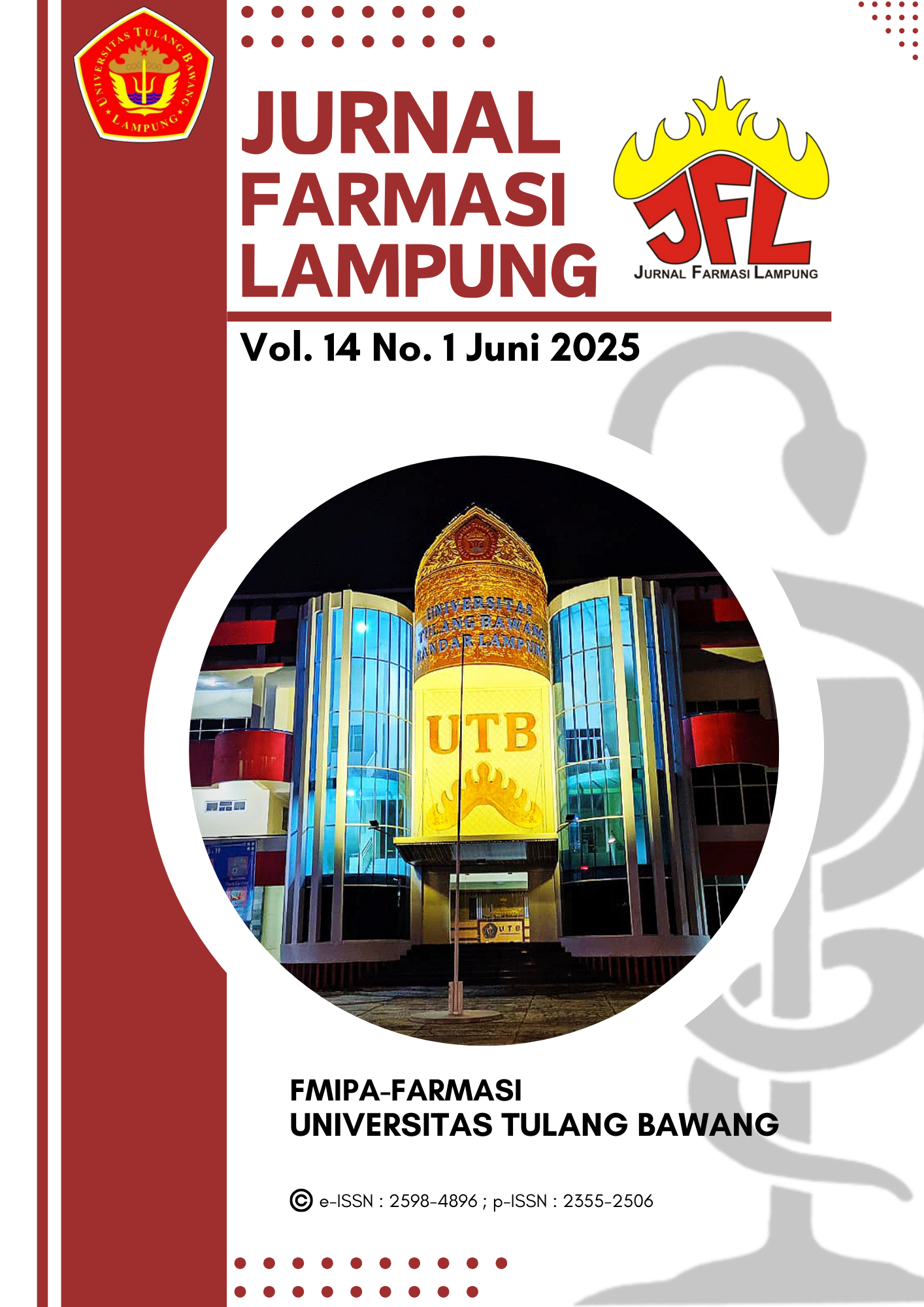UJI AKTIVITAS ANTIBAKTERI EKSTRAK ETANOL DAN FRAKSI Archidendron clypearia TERHADAP Staphylococcus aureus dan Salmonella typhi
ANTIBACTERIAL ACTIVITY TEST OF ETANOL EXTRACT AND FRACTIONS OF Archidendron clypearia OF Staphylococcus aureus and Salmonella typhi
DOI:
https://doi.org/10.37090/jfl.v14i1.2532Abstract
Infection is one of the most common causes of disease in society. One type of infection caused by Staphylococcus aureus is a bacterium that causes skin infections in humans characterized by purulent abscesses. In addition, Salmonella typhi is also a pathogenic bacterium that can cause typhoid fever. Infections caused by microorganisms can be overcome by administering antimicrobials. One of the natural ingredients that has the potential as an antimicrobial is the petai belalang plant (Archidendron clypearia). This study aims to test the antibacterial activity of ethanol extracts and fractions of petai belalang leaves against Staphylococcus aureus and Salmonella typhi bacteria. This experimental research includes plants determination, sampling, making simplisia, fractionation, phytochemical screening, and antibacterial activity tests. Extracts and fractions were prepared in concentrations of 1%, 5%, 10%, and 15%, with positive control of amoxicillin 0.1% and negative control of DMSO 1%. The antibacterial activity test was performed using disc diffusion and pitting diffusion methods to measure the zone of inhibition. Data were statistically analyzed using the Kruskal-Wallis test. The results showed that in the disc diffusion method, the inhibition zone against Staphylococcus aureus was 7.3-10.8 mm, and against Salmonella typhi was 7.6-10.1 mm. In the well diffusion method, the zone of inhibition against Staphylococcus aureus ranged from 12.1-16.8 mm, and against Salmonella typhi it ranged from 12.5-16.8 mm. The ethyl acetate fraction obtained the largest inhibition zone with a diameter of 16.8 mm in the well diffusion method. Statistical analysis showed a significant difference in antibacterial activity on positive and negative bacteria with a substantial value of 0.005 in the disc method and 0.006 in the well method.
Keywords: Antibacterial, petai belalang, Staphylococcus aureus, Salmonella typhi
Downloads
References
[1] Jumiarni, W. O., & Komalasari, O., 2017, Eksplorasi Jenis dan Pemanfaatan Tumbuhan Obat Pada Masyarakat Suku Muna di Permukiman Kota Wuna, Traditional Medicine Journal, 22 (1), 45-56.
[2] Elfrida, E., Nursamsu, N., Marfina, M., 2017, Etnobotani Tumbuhan Berkhasiat Obat Berdasarkan Pengetahuan Lokal Pada Suku Jawa Di Desa Sukarejo Kecamatan Langsa Timur Tahun 2016, Jurnal Jeumpa, 4 (1), 21-29.
[3] Kumontoy, G. D., 2023, Pemanfaatan Tanaman Herbal Sebagai Obat Tradisional Untuk Kesehatan Masyarakat di Desa Guaan Kecamatan Mooat Kabupaten Bolaang Mongondow Timur, Journal of Social and Culture, 16 (3), 5-6. https://ejournal.unsrat.ac.id.
[4] Croke, L., 2018, Guideline for transmission-based precautions, AORN Journal, 108 (6), 7-9.
[5] World Health Organization, 2014, Infection, Terdapat di: https://www.who.int/teams/integrated-health-services/infection-prevention-control/surgical-site-infection [Diakses pada 16 Oktober 2024]
[6] Ramadhani, A., Budiono, & Suhartono., 2017, Gambaran Keberadaan Bakteri Staphylococcus Aureus, Kondisi Lingkungan Fisik, Dan Angka Lempeng Total Di Udara Ruang Rawat Inap RSUD Prof. Dr. M.a Hanafiah Sm Batusangkar, Jurnal Kesehatan Masyarakat, 5 (5), 492– 501.
[7] Sulastri, E., Mappiratu, M., & Sari, A. K., 2016, Uji Aktivitas Antibakteri Krim Asam Laurat Terhadap Staphylococcus aureus ATCC 25923 dan Pseudomonas aeruginosa ATCC 27853, Jurnal Farmasi Galenika, 2 (2), 59–67.
[8] Imara, F., 2020, Salmonella typhi Bakteri Penyebab Demam Tifoid, Journal UIN Allaudin, 6 (1), 1-5. https://journal.uin-alauddin.ac.id/index.php/psb/article/view/14264/9525
[9] Niasono, A. B., Latif, H., & Purnawarman, T., 2019, Resistensi Antibiotik Terhadap Bakteri Escherichia Coli Yang Diisolasi Dari Peternakan Ayam Pedaging Di Kabupaten Subang, Jawa Barat, Jurnal Veteriner, 20 (2), 187–195. https://doi.org/10.19087/jveteriner.2019.20.2.187.
[10] Ferri, M., Ranucci, E., Romagnoli, P., & Giaccone, V., 2017, Antimicrobial resistance: A global emerging threat to public health systems, Critical Reviews in Food Science and Nutrition, 57 (13), 2857–2876. https://doi.org/10.1080/10408398.2015.1077192.
[11] Ji, W., Gu, L., Zou, X., Li, Z., Xu, X., Wu, J., Zhang, S., & Deng, H., 2023, Antibakteri dan Antidiabetes dari Archidendron clypearia Berdasarkan Kombinasi Beberapa Metode Analisis, Molecules, 0–21. https://doi.org/10.3390/molecules28031329.
[12] Bae, J. Y., Seo, Y. H., dan Oh, S. W., 2022, Aktivitas Antibakteri Polifenol Terhadap Patogen Bawaan Makanan dan Aplikasinya Sebagai Agen Antibakteri, Food Science and Biotechnology, 31, 985-997. https://doi.org/10.1007/s10068022-01058-3.
[13] Deng, X., Lei, H. -Y., Ren, Y. -S., Ai, J., Li, Y. -Q., Liang, S., Chen, L. -L., dan Liao, M. -C., 2022, Strategi Baru Untuk Identifikasi Status Kemanjuran Senyawa Aktif Dalam Jamu Cina Multi-tropisme (Scutellaria baicalensis Georgi) Berdasarkan Analisis Korelasi Abu-abu Efek Spektrum Multi-indeks, Journal of Ethnopharmacol, 300, 115677. https://doi.org/10.1016/j.jep.2022.115677.
[14] Kemit, N., Rai Widarta, W., & Nocianitri, K. A., 2016, Pengaruh Jenis Pelarut Dan Waktu Maserasi terhadap Kandungan Senyawa Flavanoid dan Aktivitas Antioksidan Ekstrak Daun Alpukat (Persea Americana Mill), Junal ITEPA, 5 (2), 130-141.
[15] Sukandar, T. K., Sukmiwati, M., & Diharmi, A., 2021, Active Fraction Of Brown Seaweed Sargassum cinereum, Berk Perikan terubuk, 49 (3), 1363-1369.
[16] Riadi, A., 2020, Pedoman Pencegahan dan Pengendalian Coronavirus Disease (COVID-19), Kementrian Kesehatan Republik Indonesia, 5.
[17] Ekawati, A. R., Supriningrum, R., & Handayani, F., 2023, Karakterisasi Ekstrak Etanol Daun Selutui Puka. Jurnal Ilmu Farmasi Dan Farmasi Klinik, 20 (1), 43–52.
[18] Qomaliyah, E. N., Indriani, N., Rohma, A., & Islamiyati, R., 2023, Skrining Fitokimia, Kadar Total Flavonoid dan Antioksidan Daun Cocor Bebek, Current Biochemistry, 10 (1), 1–10. https://doi.org/10.29244/cb.10.1.1.
[19] Mujipradhana, V. N., 2018, Aktivitas Antimikroba Dari Ekstrak Ascidian Herdmania Momus Pada Mikroba Patogen Manusia, Pharmacon, 7 (3).
[20] Aviany, H. B., & Pujiyanto, S., 2020, Analisis Efektivitas Probiotik di Dalam Produk Kecantikan Sebagai Antibakteri Terhadap Bakteri Staphylococcus epidermidis, Berkala Bioteknologi, 3 (2), 24-30.
[21] Qur’an, S. C. N., Huda, C., & Martha, R. D., 2021, Uji Aktivitas Antibakteri Fraksi Daun Eceng Gondok (Eichhornia crassipes) Terhadap Bakteri Staphylococcus aureus, Jurnal Sains dan Kesehatan, 3 (2), 194-202.
[22] Panaungi, A. N., dan Sakka, L. 2022, Perbandingan Aktivitas Ekstrak Etanol Kulit Pisang Kepok Kuning Dengan Ekstrak Etanol Kulit Pisang Kepok Mentah Terhadap Bakteri Salmonella typhi Penyebab Tifus, Journal Syifa Sciences and Clinical Research (JSSCR), 4 (1), 101-107.
[23] Balouiri, M., Sadiki, M., & Ibnsouda, S. K., 2016, Methods for In Vitro Evaluating Antimicrobial Activity, Journal of Pharmaceutical Analysis, 6 (2), 71-79. https://doi.org/10.1016/j.jpha.2015.11.005.









